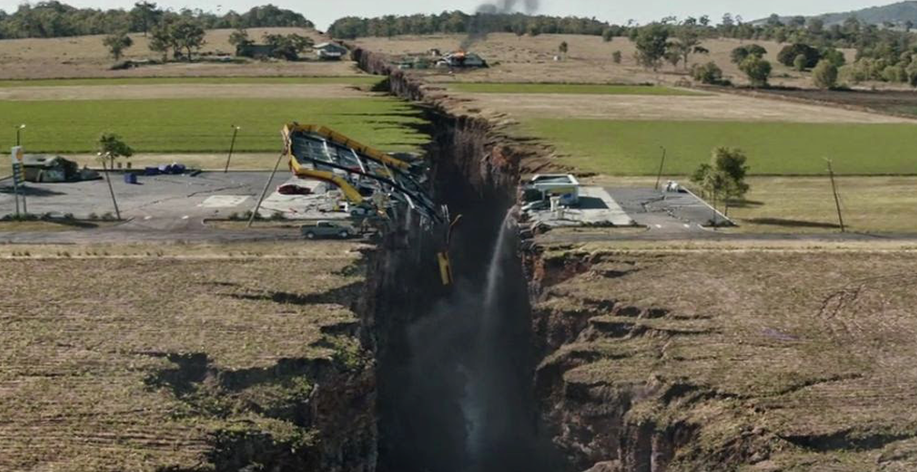Seismo Blog
The Mystery about Earthquake Fissures
Categories: Earthquake Faults and Faulting
May 4, 2017
It is one of the great myths surrounding earthquakes: During a strong temblor a gaping chasm opens up and swallows everything from humans, to animals and even houses. Sometimes these crevices are said to be many miles long. We in Northern California are partly to blame for this myth, because our seismic lore has it that during the Great San Francisco Earthquake of 1906 the valuable dairy cow Matilda vanished on a farm in Olema near Point Reyes in such a quake generated fissure. Hollywood has always been very adamant about such chasms, most recently in the totally unrealistic thriller "San Andreas" (see figure 1).

Figure 1: It doesn't get more unrealistic than this: In the movie San Andreas the fault turns into a gaping chasm. (Source: Warner Bros. Pictures, from the movie trailer)
In contrast to movie directors in their phantasy world, real field geologists have never been able to find any such crevices after an earthquake - except in areas where the quake caused the ground to slump near a slope. These fissures, however, were small and are considered only secondary effects of an earthquake, similar to the cracks which open in the ground at the top of a landslide. Researchers in Pasadena and Paris now report that gaping crevices may be not a myth at all. In laboratory experiments and numerical simulations they were able to show that certain quakes can generate such cracks, although they only exist for a very short time.
There is no doubt that strong earthquakes can cause large amounts of movement at the Earth's surface. During the 1906 quake, the ground moved by up to 18 feet. The so called Chi-Chi earthquake in Taiwan in 1999 caused ground offsets of up to 45 feet and the M=9 Tohoku earthquake, which shook Japan in March 2011, made the seafloor off of the island of Honshu jump by 150 feet. None of these rapid movements, however, generated a crevice. This observation has some strong theoretical underpinnings. During a quake the two flanks of a fault rumble and slide past each other without separating from another. The pressure which the rock surrounding a fault exerts on the fault plane is very strong and prevents such separation.
The laboratory experiments were conducted at Caltech in Pasadena in a facility jointly operated by their Seismological Lab and the Graduate Aerospace Laboratories. There earthquake ruptures are simulated in a cube of plastic material which resembles the physical conditions in the Earth's crust. For their studies, the researchers simulated thrust earthquakes, in which one flank of the fault is thrown upwards against gravity with respect to the other flank. Most of the strongest earthquakes are of this type. The simulated quakes are recorded using high-speed cameras and the resulting motion is captured by unique seismometers based on lasers.
The results of these experiments were startling. At first the rupture propagated as expected towards the Earth's surface. However shortly before it reached the top, the two flanks separated from one another for a very short time. This separation created a crevice, which then very quickly snapped closed again, resulting in the typical offset expected for a thrust quake. Figure 2 shows an animation of this movement. The laboratory observations were later confirmed by researchers at the École Normale Supérieure in Paris through numerical calculations.
How do the researchers explain the unexpected openings and closings of the fissures? When the rupture gets close to the earth's surface, the pressure by the surrounding rock drops. As a consequence, the upwards moving flank starts to bend a little bit. The resulting torque makes the two flanks separate for a short time. Once this torque energy is used up, the crevices snap shut again. Both research groups have just published their results in a joint paper in the British journal "Nature" (doi:10.1038/nature22045). One fundamental question does remain. These chasms may never be observed in a real earthquake, since a thrust quake is strong enough to generate the fissures, will likely also be powerful enough to destroy any measuring tools close enough to observe them. (hra140)
Figure 2:Animation of the rupture simulation which created a crevice - at least for a very brief time. (Credit: Harsha Bhat, Caltech)
BSL Blogging Team: Who we are
Recent Posts
-
: Alerts for the Whole West Coast
-
: Destruction in the Eastern Aegean Sea
-
: An Explosion in Beirut heard all over the Middle East
View Posts By Location
Categories
- Alaska (3)
- Bay Area (24)
- Buildings (3)
- Calaveras (4)
- California (13)
- California ShakeOut (3)
- Central California (4)
- Chile (4)
- Earthquake Early Warning (10)
- Earthquake Faults and Faulting (44)
- Earthquake Science (3)
- Haiti (3)
- Hayward (12)
- Indonesia (4)
- Induced Seismicity (3)
- Instrumentation (18)
- Italy (6)
- Japan (7)
- MOBB (3)
- Mendocino Triple Junction (5)
- Mexico (7)
- Nepal (3)
- North Korea (5)
- Nuclear Test (5)
- Ocean Bottom Seismometer (3)
- Oklahoma (4)
- Plate Tectonics (18)
- Preparedness, Risks, and Hazards (16)
- Salton Sea (3)
- San Andreas Fault (14)
- Seismic Waves (13)
- Seismograms (4)
- ShakeAlert (3)
- Southern California (5)
- Surface Waves (3)
- Today in Earthquake History (20)
- Volcanoes (4)
- subduction (3)